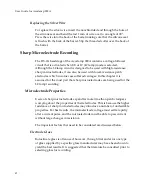
Guide
to
Electrophysiological
Recording
more
to
the
noise,
the
greater
length
may
provide
the
needed
clearance
between
the
headstage
case
and
other
components
in
the
experimental
setup.
To
further
minimize
the
noise
contributed
by
the
holder
in
single
‐
channel
recording,
the
holder
uses
a
small
(1
mm)
pin
for
the
electrical
connection
and
a
large
amount
of
insulating
Teflon.
Mechanical
stability
of
the
electrode
is
assured
in
several
ways
(see
Figure
44).
As
the
pipette
cap
is
closed,
the
cone
washer
is
compressed
on
the
electrode
from
the
force
applied
to
the
front
and
back
of
the
cone
washer.
The
cap
also
forces
the
blunt
end
of
the
electrode
against
the
rear
wall
of
the
holder
bore.
(The
electrode
should
always
be
inserted
as
far
as
it
will
go
in
the
holder.)
The
holder
mates
with
the
threaded
Teflon
connector
on
U
‐
type
Molecular
Devices
headstages
and
is
secured
in
place
with
a
threaded
collar.
Figure
44.
Exploded
view
of
the
HL
‐
U
holder.
The
bore
size
of
the
HL
‐
U
accepts
pipettes
with
an
outer
diameter
(OD)
of
1.0–1.7
mm.
Pipettes
are
secured
by
a
cone
washer
with
an
inner
diameter
(ID)
that
accommodates
the
pipette
OD.
Color
‐
coding
aids
identification
of
the
four
sizes
of
cone
washers:
1.0
mm
(orange),
1.3
mm
(clear),
1.5
mm
(orange)
and
1.7
mm
(clear).
When
the
pipette
OD
falls
between
two
sizes
of
cone
washers,
the
larger
size
cone
washer
should
be
used.
For
instance,
if
the
pipette
OD
is
1.6
mm,
then
use
a
cone
washer
with
an
ID
of
1.7
mm.
An
Ag/AgCl
pellet
offers
no
greater
stability
than
properly
chlorided
silver
wire.
Moreover,
the
diameter
of
the
pellet
(1
mm)
restricts
its
use
to
pipettes
with
a
large
ID
(>
1.1
mm).
Therefore,
the
HL
‐
U
is
supplied
with
0.25
mm
silver
wire,
which
must
be
chlorided
before
use
(see
below).
79
















































